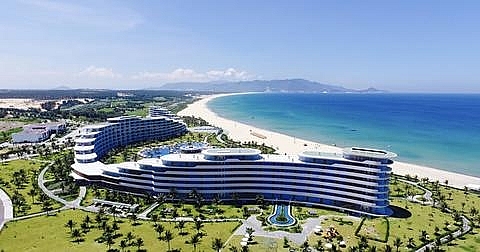Smooth waters for seaside porperty market
 |
| A view of FLC Quy Nhon in the central Binh Dinh Province. -VNS Photo |
Han Manh Tien, chairman of Vietnam Association of Corporate Directors told the Vietnam Seaside Tourism Real Estate Forum 2018 in Ha Noi on Saturday that Vietnam had many catalysts for tourism growth.
The country has macroeconomic indicators favouring development growth; infrastructure improvements, especially with Phu Quoc and Van Don connected to the national grid; airport upgrades, relaxation of visa requirements, and the rise of the middle class which is becoming a main momentum for growth in the domestic tourism market.
“In addition, Vietnam has a lot of market opportunities, especially when new developers want a piece of the “cake”. The biggest developers are also working directly with the Government to expedite large infrastructure projects, such as metro lines in Ha Noi and HCM City,” he said.
Michael Piro, chief operating officer of Indochina Capital said there were nearly 13 million international tourist arrivals last year, 29 per cent higher than 2016 with a five-year compounded annual growth rate (CAGR) of 14 per cent per annum.
The highest number of visitors was from China and South Korea with the amount growing.
But, he added, Vietnam should not rely on this too much.
The number of domestic tourist arrivals in Vietnam last year was 73.2 million people, 18 per cent higher than in 2016, with a five-year CAGR of 16 per cent per annum.
Vietnam’s air passenger traffic growth is highest in Southeast Asia, with a five-year CAGR of 17.4 per cent.
He said that those factors would greatly contribute to the development of Vietnam seaside real estate, especially in young Vietnamese markets like Nha Trang, Da Nang and Phu Quoc beach resort markets.
In Nha Trang, the average daily rate (ADR) in both four-and five-star properties has remained flat. While demand has continued to increase, the lack of supply of branded properties has hurt the market’s performance. However, occupancy has remained extremely high, reinforcing the potential.
However, Vietnam tourism must also face a number of challenges as overdevelopment is damaging Việt Nam’s pristine beaches.
Low-quality resort developments have started to flood the market. Good short-term results do not mean long-term success; therefore, developers need to continually adapt to avoid an outdated resort and create a timeless property.
Michael Piro also said that guaranteed returns in Vietnam are unparalleled; certain developers are offering 8-12 per cent returns over a period of 8-10 years.
“No one in the world is offering this level of returns,” he said.
This could also suggest poor cash flow management as it is extremely difficult to generate these types of returns organically and cash management is an important aspect of real estate development. Guaranteed returns can be used, but its use should be restrained.
Sharing the ideas, Duong Thuy Dung, senior director of CBRE Vietnam said while Thailand is a giant tourist hub in the region, seaside tourism here still has much room for development. Vietnam is estimated to attract the most significant amount of cross-border investment for the next 12 months among APEC economies.
According to CBRE statistics, real estate products of Vietnam’s coastal provinces are improving in both quantity and quality, especially in the four famous destinations, namely Ha Long, Da Nang, Nha Trang and Phu Quoc.
By 2020, the room stock of hotels, condotels and villas was expected to sharply increase by half to more than 34,000 rooms as in Nha Trang, and even double in Phu Quoc and Da Nang.
The hotel segment has shown excellent performance with the occupancy rate all above 60 per cent for four-star and five-star hotels. Resort products, including condotels and villas, also experience a high absorption rate of above 90 per cent.
It is estimated that by 2035, half of the Vietnamese population will be middle class, who are both potential investors and major customers for the tourism industry.
However, Dung also warns investors about chronic problems of the market. The legality of condotels still lacks consensus, and investors have to cope with such investment risks as profit commitments.
Environmental issues are also hard to ignore. Vietnam’s tourism industry heavily depends on natural landscapes and elements, so environmental degradation like the garbage mountains in Phu Quoc or coastal erosion in Da Nang may put a grim future on these famous destinations.
The forum is by Theleader magazine each year aiming to contribute to planning, investment, management and sustainable developments.
What the stars mean:
★ Poor ★ ★ Promising ★★★ Good ★★★★ Very good ★★★★★ Exceptional
Related Contents
Latest News
More News
- PM urges Ho Chi Minh City to innovate and remain Vietnam’s economic locomotive (November 26, 2025 | 15:29)
- Experts chart Vietnam's digital finance path: high hopes, high stakes (November 14, 2025 | 10:56)
- Vietnam’s seafood imports surge 30 per cent in first 10 months (November 10, 2025 | 19:35)
- Vietnam’s durian exports hit $1 billion milestone (October 30, 2025 | 17:41)
- Beyond borders: Sunhouse and new era of Vietnamese brands on Amazon (October 28, 2025 | 10:46)
- Record-breaking trade fair set to open in Hanoi (October 15, 2025 | 15:59)
- Timber sector seeks solutions to VAT refunds (October 14, 2025 | 18:58)
- Tether explores investment prospects in Vietnam’s digital asset sector (October 10, 2025 | 18:09)
- Vietnamese investors pour nearly $847 million into overseas markets in nine months (October 08, 2025 | 18:42)
- Vietnam amends Law on Civil Aviation to create drive airport investment (October 03, 2025 | 18:29)

 Tag:
Tag:






















 Mobile Version
Mobile Version